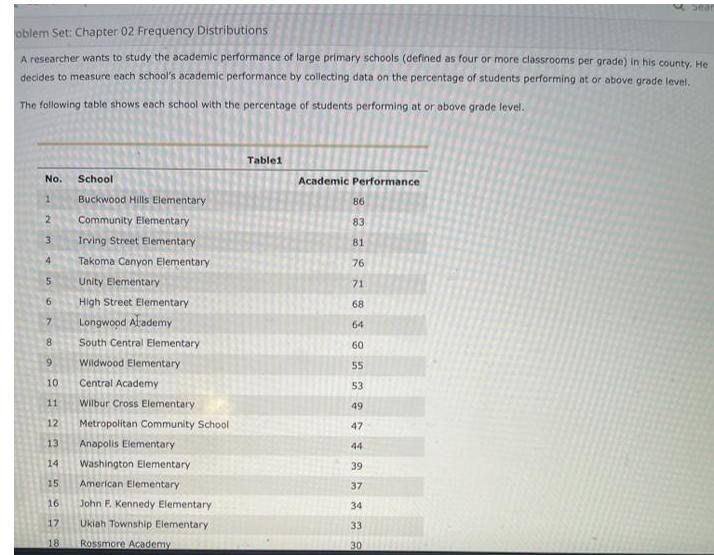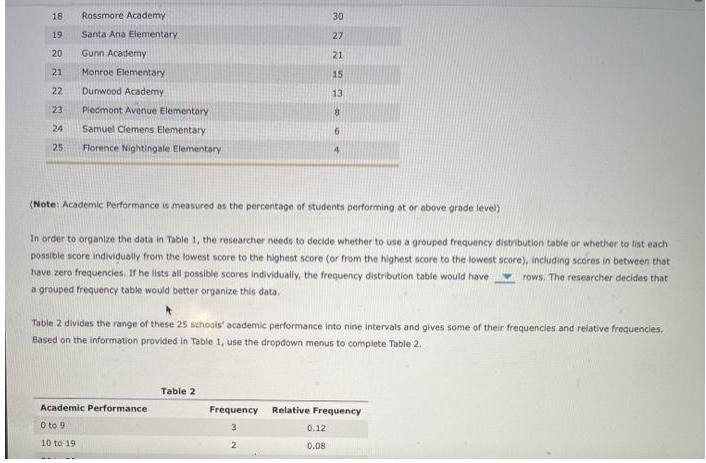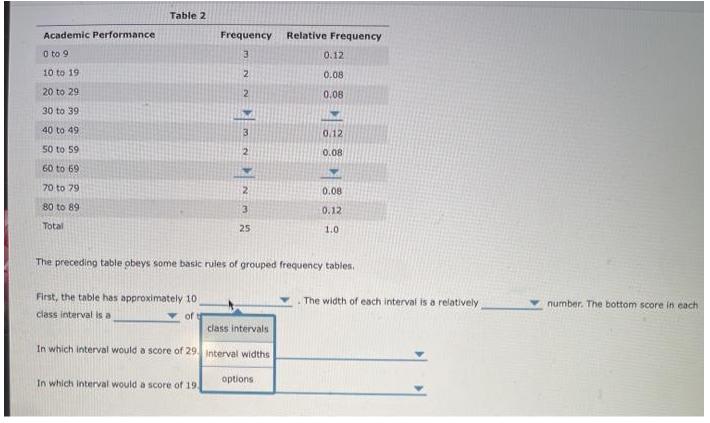Answered step by step
Verified Expert Solution
Question
1 Approved Answer
Frequency Distributions A researcher wants to study the academic performance of large primary schools (defined as four or more classrooms per grade) in his



Frequency Distributions A researcher wants to study the academic performance of large primary schools (defined as four or more classrooms per grade) in his county. He decides to measure each school's academic performance by collecting data on the percentage of students performing at or above grade level. The following table shows each school with the percentage of students performing at or above grade level. No. School 1 Buckwood Hills Elementary 2 Community Elementary 3 Irving Street Elementary 4 Takoma Canyon Elementary Unity Elementary High Street Elementary Longwood Alademy 8 South Central Elementary 9 Wildwood Elementary 567 10 Central Academy 2224 11 Wilbur Cross Elementary 12 Metropolitan Community School 13 Anapolis Elementary 14 Washington Elementary 15 American Elementary 16 17 18 John F. Kennedy Elementary Ukiah Township Elementary Rossmore Academy Table1 Academic Performance 86 83 81 76 71 68 64 60 55 53 49 47 44 39 37 34 33 30 3002ND 18. 19 21 22 24 25 Rossmore Academy Santa Ana Elementary Gunn Academy Monroe Elementary Dunwood Academy Piedmont Avenue Elementary Samuel Clemens Elementary Florence Nightingale Elementary (Note: Academic Performance is measured as the percentage of students performing at or above grade level) Academic Performance 0 to 9 10 to 19 In order to organize the data in Table 1, the researcher needs to decide whether to use a grouped frequency distribution table or whether to list each possible score individually from the lowest score to the highest score (or from the highest score to the lowest score), including scores in between that have zero frequencies. If he lists all possible scores individually, the frequency distribution table would have rows. The researcher decides that a grouped frequency table would better organize this data. 30 27 21 15 13 8 Table 2 divides the range of these 25 schools academic performance into nine intervals and gives some of their frequencies and relative frequencies. Based on the information provided in Table 1, use the dropdown menus to complete Table 2. Table 2 6 4 2 0.12 0.08 Frequency Relative Frequency. 3 Academic Performance 0 to 9 10 to 19 20 to 29 30 to 39 40 to 49 50 to 59 60 to 69 70 to 79 80 to 89 Total Table 2 First, the table has approximately 10 class interval is a of Frequency 3 2 2 ibad 3 2 M 2 In which interval would a score of 19 3 25 class intervals In which interval would a score of 29 Interval widths The preceding table obeys some basic rules of grouped frequency tables. Relative Frequency options 0.12 0.08 0.08 M 0/12 0.08 0.08 0.12 1.0 The width of each interval is a relatively, number. The bottom score in each
Step by Step Solution
★★★★★
3.48 Rating (155 Votes )
There are 3 Steps involved in it
Step: 1
The detailed ...
Get Instant Access to Expert-Tailored Solutions
See step-by-step solutions with expert insights and AI powered tools for academic success
Step: 2

Step: 3

Ace Your Homework with AI
Get the answers you need in no time with our AI-driven, step-by-step assistance
Get Started


